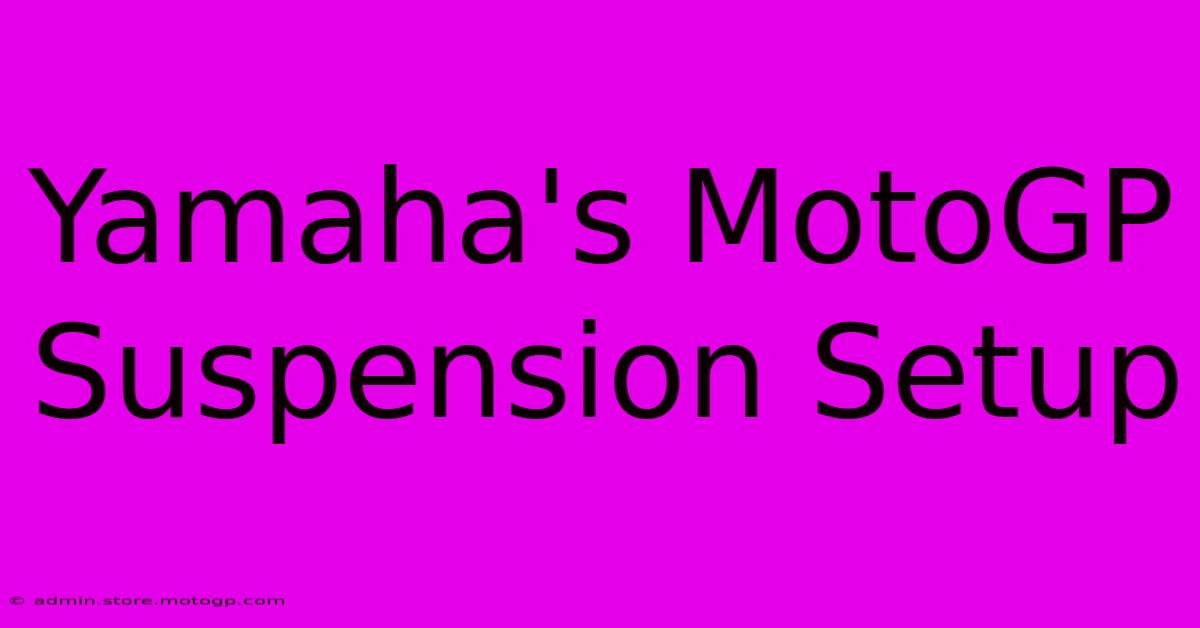Yamaha's MotoGP Suspension Setup

Table of Contents
Yamaha's MotoGP Suspension Setup: A Deep Dive into the Secrets of Success
Yamaha's MotoGP bikes are renowned for their exceptional handling and agility. A significant contributor to this performance is their meticulously crafted suspension setup. Understanding the intricacies of this setup is key to appreciating Yamaha's competitive edge on the track. This article will delve into the key components, adjustments, and strategies employed by Yamaha's engineers to optimize their machines for various track conditions.
The Key Players: Ohlins and Yamaha's Expertise
Yamaha primarily utilizes Öhlins suspension components, a partnership that has yielded significant success. Öhlins, a Swedish manufacturer, is a leader in high-performance suspension technology. Their forks and shock absorbers are known for their precision, adjustability, and responsiveness. However, it's not just the components themselves; Yamaha's engineers play a crucial role in fine-tuning and optimizing these Öhlins units to perfectly match their bike's chassis and the rider's style.
Front Suspension: Fork Dynamics
The front forks are a critical element, influencing turn-in, stability, and braking performance. Yamaha’s engineers meticulously adjust several key parameters:
- Spring Preload: This determines the initial compression of the spring, impacting the bike's ride height and handling characteristics. Adjustments are made based on track conditions, rider weight, and tire pressures.
- Compression Damping: This controls the speed at which the fork rebounds after compression. Proper settings are vital for absorbing bumps and maintaining stability during braking. Yamaha's engineers work to find the optimal balance between comfort and responsiveness.
- Rebound Damping: This governs the speed at which the fork extends after compression. Optimizing rebound damping is crucial for maintaining contact with the track surface and preventing unwanted oscillations.
Rear Suspension: Shock Absorption and Traction
The rear suspension, also an Öhlins unit, is equally crucial. Yamaha’s engineers meticulously adjust parameters such as:
- Spring Rate: This determines the stiffness of the spring, influencing the bike's ability to absorb bumps and maintain traction. The spring rate is tailored to the specific track and rider preferences.
- High-Speed Compression Damping: This affects how the shock absorber reacts to larger impacts, ensuring stability and preventing bottoming out.
- Low-Speed Compression Damping: This impacts the shock's behavior under smaller bumps and during acceleration and braking, influencing traction and rider feel.
- Rebound Damping: Similar to the front, rear rebound damping influences traction and stability. A precise setting helps maintain consistent contact with the track.
Data-Driven Optimization: The Role of Telemetry
Yamaha's approach isn't just about mechanical adjustments; it's heavily data-driven. Extensive use of telemetry allows engineers to gather real-time data on suspension performance under various conditions. This data provides valuable insights, enabling them to fine-tune the setup for optimal performance. Factors like suspension travel, g-forces, and tire pressure are meticulously analyzed to optimize the setup.
Rider Input: A Crucial Component
While technology plays a dominant role, the rider's feedback is indispensable. Yamaha's riders, such as Fabio Quartararo and Maverick Viñales (previously), provide critical input on the bike's handling characteristics. Their experience and sensitivity allow them to identify areas where adjustments are needed, further refining the suspension setup. This collaboration between engineers and riders is a key factor in Yamaha's success.
Adaptability: The Key to Consistency
One of the remarkable aspects of Yamaha's MotoGP suspension setup is its adaptability. The ability to quickly adjust settings to suit different track conditions is crucial. This adaptability is essential in MotoGP, where various tracks present unique challenges, requiring precise adjustments to maintain competitiveness. From the fast, flowing circuits to the tighter, more technical ones, Yamaha’s adaptable setup ensures consistent performance.
Conclusion: A Symphony of Precision
Yamaha's MotoGP suspension setup is a testament to the combination of cutting-edge technology, meticulous engineering, and rider expertise. The seamless integration of Öhlins components, data-driven optimization, and rider feedback results in a finely tuned system that contributes significantly to Yamaha's success on the world stage. The ongoing evolution and refinement of this setup demonstrate Yamaha's commitment to pushing the boundaries of performance in the demanding world of MotoGP.

Thank you for visiting our website wich cover about Yamaha's MotoGP Suspension Setup. We hope the information provided has been useful to you. Feel free to contact us if you have any questions or need further assistance. See you next time and dont miss to bookmark.
Featured Posts
-
Experience The Intensity Tnt Sports Moto Gp
Feb 20, 2025
-
Moto Gp Replay Experience The Passion Of Moto Gp
Feb 20, 2025
-
F1 Concert A Night Of High Speed Entertainment
Feb 20, 2025
-
Conquer The Track Premium Motorcycle Race Bikes For Sale Now
Feb 20, 2025
-
Moto Gps Most Horrific Crashes Survivor Stories
Feb 20, 2025
